Toltec Civilization › Sicilian Temples » Origins and History
Articles and Definitions › Contents
- Toltec Civilization › Ancient History
- Sicilian Temples › Antique Origins
Ancient civilizations › Historical places, and their characters
Toltec Civilization › Ancient History
Definition and Origins
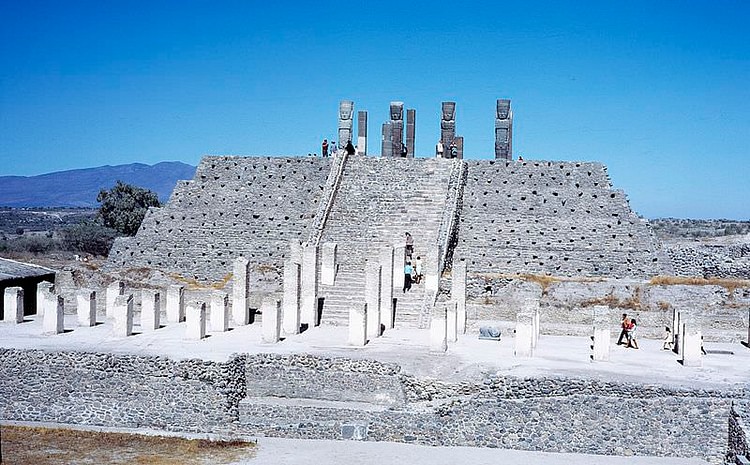
The Toltec civilization flourished in ancient central Mexico between the 10th and mid-12th centuries CE. Continuing the Mesoamerican heritage left to them by the earlier Olmec, Teotihuacan, Maya and others, the Toltecs would build an impressive capital at Tollan and, ultimately, pass on that heritage to later civilizations such as the Aztecs, who regarded the Toltecs as a great and prosperous civilization, even claiming descent from this once great civilization.
Most information on the Toltec comes from Aztec and Post-colonial texts documenting earlier oral traditions. However, these are by no means complete, and information can be coloured by the Aztec's particular reverence for all things Toltec and their delight in merging myth with fact to help establish a lineage with these old masters. Nevertheless, a careful comparison with earlier Mayan texts and the surviving archaeological record does allow for at least the main elements of this civilization to be outlined.
ORIGINS & SPREAD
The Toltecs had roots in the Tolteca-Chichimeca people, who, during the 9th century CE, had migrated from the deserts of the north-west to Culhuacan in the Valley of Mexico. According to the Aztecs, the first Toltec leader was Ce Técpatl Mixcoatl (One Flint Cloud Serpent, ie the Milky Way), and his son Ce Acatl Topiltzin (One Reed Sacrificer, born in either 935 or 947 CE) would go on to gain fame as a great ruler and acquire the name of the great god Quetzalcoatl ('Feathered Serpent') amongst his titles.
THE FIRST SETTLEMENT OF THE TOLTECS WAS AT CULHUACAN, BUT THEY LATER ESTABLISHED A CAPITAL AT TOLLAN (TULA).
The first settlement of the Toltecs was at Culhuacan, but they later established a capital at Tollan (or Tula, meaning 'place of reeds', a general Mesoamerican phrase to apply to all large settlements). The city grew to an area of 14 km² and acquired a population of between 30,000 and 40,000. The heart of the city was laid out in a grid pattern and it is remarkably similar to the Mayan city of Chichen Itza. Intriguingly, the Maya also had a version of a cultural hero known as the 'Feathered Serpent', translated as Kukulcan and contemporary with the Toltec Quetzalcóatl; this and architectural similarities, suggest that there was a close cultural link between the two civilizations.
TOLLAN
The Tollan of Aztec mythology was renowned for its sumptuous palaces and awe-inspiring buildings made from gold, jade, turquoise, and quetzal feathers. The city was also thought to have been flooded with wealth generated by the gifted Toltec craftsmen, highly skilled in metallurgy and pottery - so much so that their potters were said to have 'taught the clay to lie' (Coe, 156) and later Aztec metal-workers and jewellers were even known as tolteca. The Toltecs were also credited with mastering nature and producing huge maize crops and natural coloured cotton of red, yellow, green, and blue. Unsurprisingly, following centuries of looting, no artefacts survive to attest this material wealth except indications that the Toltecs did do a major trade in obsidian (used for blades and arrow heads) which was mined from nearby Pachuca.
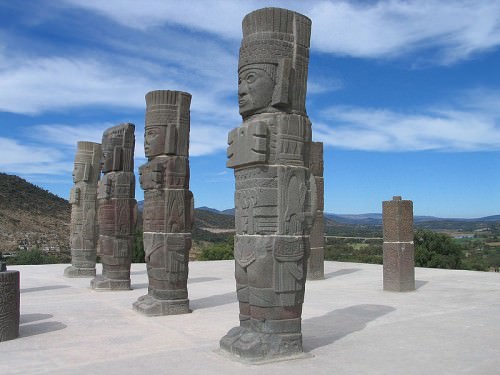
Toltec Warrior Columns
The archaeological site of Tollan, sitting on a limestone promontory, although not quite as splendid as the legend, nevertheless, has an impressive number of surviving monuments. These include two large pyramids, a collonaded walkway, a large palace building, and two ball-courts, all surrounded by a dense area of urban housing. The domestic housing is arranged in groups of up to five flat-roofed residences with each group centred on a courtyard with a single altar and the whole surrounded by a wall.
THE TOLTEC WERE A WARLIKE PEOPLE, NO DOUBT CONQUERING SURROUNDING TRIBES & IMPOSING TRIBUTE WITHOUT ANY CONCERN FOR INTEGRATION.
Surviving architectural sculpture on the pyramids includes large columns, each consisting of four drums, carved as warriors standing atop the five tiers of the 10 m high Pyramid B. The warriors would once have held up a roof structure. The warriors are dressed ready for battle with a drum headdress and butterfly pectoral and each holds an atlatl or spear-thrower at their side. In addition, feathered-snake columns survive from the original doorway. The warrior columns are near-identical and suggest sophisticated workshops capable of mass production.
Friezes run around the pyramids and a free-standing 40 m long L-shaped wall (known as a coatepantli and a Toltec innovation). They show scenes with animals such as the jaguar, wolf, and coyote (symbols associated with a warlike people like the Toltecs), and sacrifice (especially rattlesnakes and skeletons intertwined). There are also images of feathered creatures (perhaps jaguars) and eagles with hearts in their mouths.
Tollan also provides the first examples of chacmools, the reclining stone warriors clutching a vessel on their stomach to receive sacrificial offerings for the gods. These would become a common feature of temples in Mesoamerica. At Tollan they are positioned beside bench-thrones atop the pyramid temple.
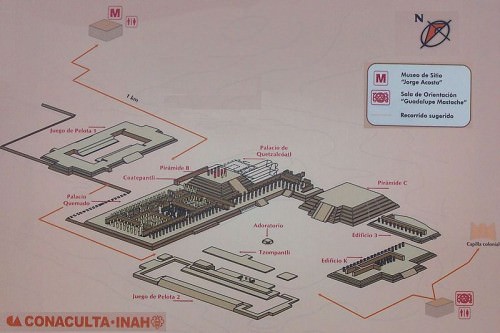
Tollan (Tula)
DECLINE
What ended the Toltec civilization's regional dominance is not known. A warlike people, no doubt conquering surrounding tribes and imposing tribute without any concern for integration into the Toltec political and religious culture, the ' empire ' may well have simply disintegrated when put under the strain of such natural phenomena as a sustained drought. Internal disputes may also have led to the break up of the power structure, and this is hinted at in the legendary stories of battles between the gods Quetzalcoatl and Tezcatlipoca, intertwined with historical figures. What is more certain is that in the mid-12th century CE, Tollán shows signs of violent destruction; many architectural columns and statues were burnt and purposely buried and the site was systematically looted by the Aztecs. Led by the final Toltec leader Huemac, the remnants of the Toltec people re-settled at Chapultepec on the west banks of Lake Texcoco, an event traditionally dated either 1156 or 1168 CE.
LEGACY
The Toltec name carried a certain prestige and they were very highly regarded by the Maya and the Aztecs, in particular, who seem to have copied many aspects of Toltec religious practices and art and looked on the Toltec period as a golden era when such wonders as writing, medicine, and metallurgy were invented. These may well have been invented earlier and by others but more certain is the Toltec influence on architecture and sculpture. Images of recognisable deities at Tollan which would later appear in the Aztec pantheon include Centeotl, Xochiquetzal, Tlahuizcalpantecuhtli and the feathered serpent identified with Quetzalcoatl. Stone carvings of cuauhxicalli vessels and chacmools used in sacrifices and also tzompantli (skull racks) all attest to the influence the Toltecs would have on their more famous successors. In any case, whatever the actual legacy of the people of Tollan, for the Aztecs it was the Toltecs and no other that they sought to claim descent from, and the magnitude of their reverence and respect is evidenced in the Aztec expression Toltecayotl or 'to have a Toltec heart' which meant to be worthy and to excel in all things.
Sicilian Temples › Antique Origins
Ancient Civilizations
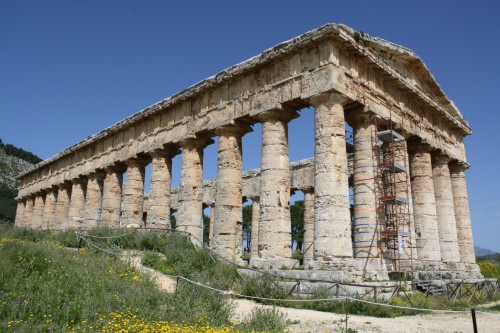
Temple of Segesta
CHARACTERISTICS OF SICILIAN ARCHAIC TEMPLES
The large dimensions of the components, the presence of a propteron, an adyton, and other specific elements of the plan and elevation speak for an originally very autonomous development of Sicilian architecture. The large quantities of available and easy-to-work-with building materials at the sites of Syracuse, Megara Hyblaea, and Selinunte enabled the establishment of the first generation of stone temples in Sicily ; the metropoleis were still busy with the process of becoming a city (p olis ) and had not formed monumental architecture yet. In the 6th century BCE the eastern Sicilian colonies were at the forefront of structural developments on the island and had predetermined the tendencies for their later development. The oldest stone buildings in these poleis – the Temple of Apollo, that of Olympian Zeus in Syracuse, some remains of buildings from Megara Hyblaea, and the remains of the Temple Y in Selinunte were thus intended from the outset as monumental.
THE PERISTASIS
Peristasis (gr. Περίστασις) is a four-sided porch or hall of columns surrounding the cella. Temples with such halls of columns, called peripteros (pl. peripteroi), were widespread in the western Greek world from very early on. The western peripteroi were often much more valuable and abundant than the ones in the mother cities. Very characteristic of the earliest peripteral temples in Sicily is the extension of the hall on the front side (propteron), which probably its origins in the ionic Dipteroi (temples with double colonnades). Most likely the peristasis was built chronologically before the cella, although the structure of the cella decided the number of columns. The late binding of the front of the cella to the front of the peristasis had a strong effect on the overall proportions of the building.
THE CORNER CONFLICT IN THE DORIC ARCHITECTURAL ORDER
Not less important is the relation between the plan and the triglyphon (triglyph and metope as a unit). The regularly alternating triglyphs and metopes in the frieze were accented through strong colours and played a very important role in addition to other proportions. The rhythm that results from the sequence of columns and intercolumniations repeats in the frieze so that one triglyph is always located at the central axis of the column and one in intercolumniation. Therefore, the ratio of column thickness and intercolumniation reflects the ratio of the width of the triglyphs and metopes in the frieze. If the intercolumniation equals the metope width at the end of the frieze, an irregularity arises (corner conflict): the last triglyph was not cantered with the corresponding column. Ancient Greeks were very sensitive to this. A harmonic solution of this irregularity was achieved by the reduction (contraction) of the last intercolumniation on the long side of the temple. This type of solution was preferred in the eastern Greek world and was also held in Italy and Sicily but rather unfavourably. In fact, we find no archaic temple in Sicily that has this simple corner contraction. Either the sensitivity for regularity and symmetry in this early period was not yet developed, or this solution was not understood by Sicilian architects. The later Doric buildings in Sicily have a double contraction, which mitigates the forced irregularities in the frieze by changing the width, not only of the last intercolumniation, but also of the one following it. This solution of the Doric conflict has been implemented in many different ways in different times and places and on diverse buildings. At the end of the archaic period, it goes against the striving for rational regularity of the construction and for equal intercolumniations.
DIFFERENTIATION OF INTERCOLUMNIATIONS
In the early Sicilian temples, it is noticeable that the spaces between the columns on the narrow and long sides have all different sizes. This applies to the Temple of Apollo and the one of Zeus Olympios in Syracuse as well as Temple C in Selinunte. On temples from the late archaic period like F and G in Selinunte, this difference is already much smaller. It is important to note that this is not an intended differentiation in favour of the solution of the corner conflict, but a lack of regularity which is normal for this early period.
Other characteristics in the plan of earlier Doric temples in Sicily can be found in the arrangement of the internal construction.The archaic cella consists of a pronaos (entrance hall), usually in antis, and a naos (the inner structure of a temple, cella). The adyton is a small place at the back of the hall where the cult statue for a temple was often kept, and it remains typical for the early phase of temple architecture in Sicily. The lack of the back hall and the presence of the propteron are two elements that give the temple front more weight and detach the whole construction of the idea of universalism and symmetry.
These are only the general lines of development that can be observed in Sicily during the archaic period.
APOLLONION (SYRACUSE, 600/575 BCE)
| Columns Proportion | 6 x 17 |
|---|---|
| Stylobate | 21.57 x 55.36 m |
| Intercolumn. Long side (LS) Front side (FS) Middle Intercolumn.(MI) | LS – 3.33 m FS – 3.90 m MI – 4.15 m |
| Corner Contraction | none |
| Propteron | 2 interc. deep; wide MI |
| Cella width x Length | 11.77 mx 37.2 m |
| Pronaos/Cella Front | 2 in antis |
| Arrangement of Inner Columns | double colonnade |
| Adyton or Opisthodom | Adyton |
| Column Height | 7.98 m |
| Lower Diameter | 2.05 m |
| Lower D x Column Height | 1 : 3 |
| Architrave Height | 2.15 m |
| D : Intercolumn. | 7 : 8 7 : 10 |
| Frieze Proportion Triglyph Width : Metope Width | No consideration |
| Corner conflict in frieze | No consideration |
| Foot/Ell* | 49-50 cm = 1 E |
OLYMPIEION (SYRACUSE, 560 BCE)
| Columns Proportion | 6 x 17 |
|---|---|
| Stylobate | 22.04 x 62.02 m |
| Intercolumn. Long side (LS) Front side (FS) Middle Intercolumn.(MI) | Almost equal |
| Corner Contraction | none |
| Propteron | 2 interc. deep Normal MI |
| Cella width x Length | - |
| Pronaos/Cella Front | 2 in antis |
| Arrangement of Inner Columns | none |
| Adyton or Opisthodom | Adyton |
| Column Height | c. 8 m |
| Lower Diameter | 1.84 m |
| Lower D x Column Height | 1 : 4,3 |
| Architrave Height | - |
| D : Intercolumn. | - |
| Frieze Proportion Triglyph Width : Metope Width | With consideration |
| Corner conflict in frieze | - |
| Foot/Ell* | - |
TEMPLE C (SELINUNTE, 560/550 BCE)
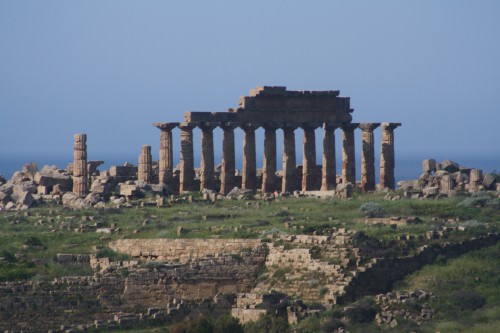
Temple C, Selinus
| Columns Proportion | 6 x 17 |
|---|---|
| Stylobate | 23.93 x 63.76 m |
| Intercolumn. Long side (LS) Front side (FS) Middle Intercolumn.(MI) | LS – 3.86 m avg. FS – 4.41 m avg. In gradation on the east front |
| Corner Contraction | none |
| Propteron | 2 interc. Deep Normal MI |
| Cella width x Length | 10.40 x 40.89 m almost 1 : 4 / 20:80 ell |
| Pronaos/Cella Front | antae |
| Arrangement of Inner Columns | none |
| Adyton or Opisthodom | Adyton |
| Column Height | 8.76 m/ 8.65 m |
| Lower Diameter | c. 1.9 m |
| Lower D x Column Height | 1: 4.53 |
| Architrave Height | - |
| D : Intercolumn. | 3 : 4 4/14 |
| Frieze Proportion Triglyph Width : Metope Width | 9 : 10 The first regulated entablature proportion |
| Corner conflict in frieze | Not relevant |
| Foot/Ell* | 52 cm = 1 E |
TEMPLE D (SELINUNTE, C. 550 BCE)
| Columns Proportion | 6 x 13 |
|---|---|
| Stylobate | 23.63 x 55.96 m |
| Intercolumn. Long side (LS) Front side (FS) Middle Intercolumn.(MI) | LS – 4.51 m avg. FS – 4.37 m avg. Geringere Jochdiff. |
| Corner Contraction | none |
| Propteron | none |
| Cella width x Length | 9.87 x 39.28 m almost 1 : 4 / 20:80 ell |
| Pronaos/Cella Front | Tetrastyle 2 col. + 2 ¾ col. |
| Arrangement of Inner Columns | none |
| Adyton or Opisthodom | Adyton |
| Column Height | 8.35 m |
| Lower Diameter | - |
| Lower D x Column Height | 1 : 5 |
| Architrave Height | - |
| D : Intercolumn. | 3 : 5 4/5 |
| Frieze Proportion Triglyph Width : Metope Width | 8 : 9 |
| Corner conflict in frieze | No consideration |
| Foot/Ell* | 49.1 cm = 1E |
TEMPLE F (SELINUNTE, 550 BCE)
| Columns Proportion | 6 x 14 |
|---|---|
| Stylobate | 24.37 x 61.88 m |
| Intercolumn. Long side (LS) Front side (FS) Middle Intercolumn.(MI) | LS – 4.60 m FS – 4.47 m |
| Corner Contraction | none |
| Propteron | 2 interc. deep |
| Cella width x Length | c. 9.20 x 40 m |
| Pronaos/Cella Front | antae |
| Arrangement of Inner Columns | ?/none |
| Adyton or Opisthodom | Adyton |
| Column Height | 9.11 m |
| Lower Diameter | 1.79 m |
| Lower D x Column Height | c. 1 : 5 |
| Architrave Height | - |
| D : Intercolumn. | 3:6 |
| Frieze Proportion Triglyph Width : Metope Width | 5:6 |
| Corner conflict in frieze | Widening of the corner metopes |
| Foot/Ell* | - |
TEMPLE G (SELINUNTE, 520 BCE)
| Columns Proportion | 8 x 17 |
|---|---|
| Stylobate | 49.97 x 109.12 m +/- 5 cm |
| Intercolumn. Long side (LS) Front side (FS) Middle Intercolumn.(MI) | East: 6.52 m avg. West: normal interc. – 6.62 m angle interc. – 6.28 m |
| Corner Contraction | East - none /West – single |
| Propteron | None/ 2 interc. deep Peristasis (c. 12 m) |
| Cella width x Length | 22.50 x 69.10 m |
| Pronaos/Cella Front | 4 x 2 Prostyle and antae |
| Arrangement of Inner Columns | double colonnade |
| Adyton or Opisthodom | Opisthodomos |
| Column Height | 14.7 m |
| Lower Diameter | East – 2.97 m West – 3.26 m |
| Lower D x Column Height | East – 1 : 5/ West – 1 : 4 ½ |
| Architrave Height | - |
| D : Intercolumn. | East : 9 : 17 |
| Frieze Proportion Triglyph Width : Metope Width | 9 : 13 |
| Corner conflict in frieze | Widening of the corner metopes (?) |
| Foot/Ell* | - |
Heracles ( Agrigento, 488 BCE)
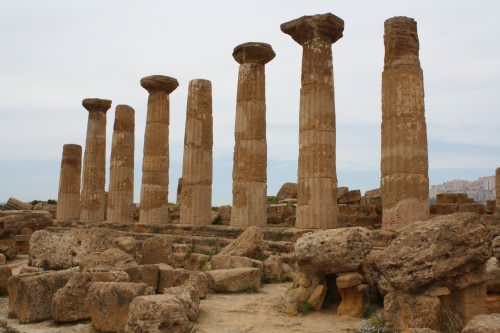
Temple of Hercules, Agrigento
| Columns Proportion | 6 x 15 |
|---|---|
| Stylobate | 25.33 x 67 m / 25.28 x 67.04 = 3 : 8 |
| Intercolumn. Long side (LS) Front side (FS) Middle Intercolumn.(MI) Angle Intercolumn. (AI) | LS – 4.612 m avg. West: NS – 4.62 m = LS Unit intercolumniation! (UI) MI – 4.605 m AI– 4.52 m |
| Corner Contraction | single, (8 – 12 cm); only at the front |
| Propteron | 2 interc. deep; East end West |
| Cella width x Length | 11.85 x 29.64 m 36 x 90 Fuß |
| Pronaos/Cella Front | 5.55 m deep; 2 in antis |
| Arrangement of Inner Columns | none |
| Opisthodomus | 5.38 m deep in antis |
| Binding of the Cella | To the 2d column on FS and the 3th on LS |
| Column Height | - |
| Lower Diameter | - |
| Lower D x Column Height | - |
| Frieze Proportion W=Width; H=Height | - |
| Corner conflict in frieze | No consideration |
| I' | 29,64 cm Ion. F. |
Olympieion (Agrigento, 488? BCE)
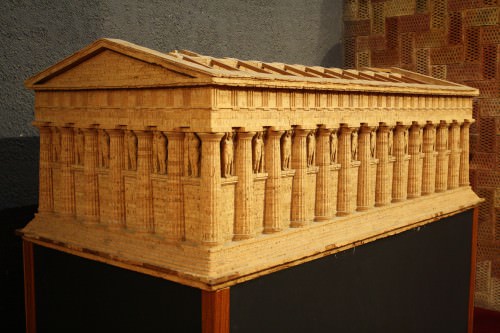
Temple of Zeus Model, Agrigento
| Columns Proportion | 7 x 14/ 1: 2 |
|---|---|
| Stylobate | 44.01 x 101.16 m |
| Intercolumn. Long side (LS) Front side (FS) Middle Intercolumn.(MI) Angle Intercolumn. (AI) | LS – 8.12 m FS – 8.08 m (NormalI) No MI |
| Corner Contraction | none |
| Propteron | 1 interc. deep |
| Cella width x Length | 2 x 11 interc. |
| Pronaos/Cella Front | 1 inter. deep |
| Arrangement of Inner Columns | 2 x 12 pillars |
| Opisthodomus | 1 inter. deep |
| Binding of the Cella | To the 3th and 5th column on FS |
| Column Height | 18.20 m (?) |
| Lower Diameter | 4.50 m / 4.42 m ? |
| Lower D x Column Height | C. 1 : 4 |
| Frieze Proportion W=Width; H=Height | TrW : MetW = 4 : 5 TrW : TrH = 7: 4 |
| Corner conflict in frieze | No consideration |
| I' | 32.6 cm |
BIG TEMPLE OF HIMERA (480 /466 BCE)
| Columns Proportion | 6 x 14 /3 : 7 |
|---|---|
| Stylobate | 22.46 x 55.91 m 68´ x 170´ almost 2 : 5 |
| Intercolumn. Long side (LS) Front side (FS) Middle Intercolumn.(MI) Angle Intercolumn. (AI) | NI – 4.19 m = MI AI LS = AI FS – 3.99 m = 12´ |
| Corner Contraction | double |
| Propteron | - |
| Cella width x Length | 11.17 x 39.46 m 34´ x 120´ |
| Pronaos/Cella Front | 2 in antis |
| Arrangement of Inner Columns | none |
| Opisthodomus | yes |
| Binding of the Cella | none |
| Column Height | - |
| Lower Diameter | 1.91 m |
| Lower D x Column Height | - |
| Frieze Proportion W=Width; H=Height | TrW : MetW = 2 : 3 TrW : TrH = 3 : 5 |
| Corner conflict in frieze | no consideration |
| I' | 32.888 cm |
ATHENAION (SYRACUSE, C. 470 BCE)
| Columns Proportion | 6 x 14/ 3 : 7 |
|---|---|
| Stylobate | 22.20 x 55.45 m 68´ x 170´ 2 : 5 |
| Intercolumn. Long side (LS) Front side (FS) Middle Intercolumn.(MI) Angle Intercolumn. (AI) | NI – 4.16 m MI – 4. 20 m |
| Corner Contraction | double |
| Propteron | C. 1 ½ interc. deep |
| Cella width x Length | 12.50 x 42 m |
| Pronaos/Cella Front | 2 in antis |
| Arrangement of Inner Columns | none |
| Opisthodomus | yes |
| Binding of the Cella | To the 2d column on the FS |
| Column Height | 8.78 m avg. |
| Lower Diameter | 1.97 m |
| Lower D x Column Height | 1 : 4 ½ |
| Frieze Proportion W=Width; H=Height | TrW : MetW = 2 : 3 Trw : TrH = 3 : 5 |
| Corner conflict in frieze | No consideration |
| I' | 32,6206 cm |
HERAION (E 3) (SELINUNTE, 470 BCE)

Temple of Hera, Selinus
| Columns Proportion | 6 x 15/ c. 3 : 8 |
|---|---|
| Stylobate | 25. 30 x 67.74 m |
| Intercolumn. Long side (LS) Front side (FS) Middle Intercolumn.(MI) Angle Intercolumn. (AI) | UI – 4.70 - 4.73 m AI - 4.37 m |
| Corner Contraction | single |
| Propteron | 1 ½ interc. deep |
| Cella width x Length | c. 14 x 50 m 2 : 7 or 1 : 3 ½ |
| Pronaos/Cella Front | 2 in antis |
| Arrangement of Inner Columns | none |
| Opisthodomus | Opisth + Adyton |
| Binding of the Cella | To the 2d column on the FS and in the middle of the 2d interc. on LS |
| Column Height | 10.35 m |
| Lower Diameter | 2.23 m |
| Lower D x Column Height | 1:4 |
| Frieze Proportion W=Width; H=Height | TrW : MetW = 1 : 1,42 TW : TrH = ca. 4 : 7 |
| Corner conflict in frieze | .19 m |
| I' | - |
TEMPLE A (SELINUNTE, 450 BCE)
| Columns Proportion | 6 x 14 |
|---|---|
| Stylobate | 16.13 x 40.31 m C. 1 : 2 ½ / 2 : 5 |
| Intercolumn. Long side (LS) Front side (FS) Middle Intercolumn.(MI) Angle Intercolumn. (AI) | NI LS – 2.99 m AI LS – 2.89 m MI – 2.98 m AI FS – 2.85 m |
| Corner Contraction | needed – 0.273 m Front – 0.169 m double Side – 0.96 m single |
| Cella Width x Length | - |
| Pronaos/Cella Front | 2 in antis |
| Arrangement of Inner Columns | staircases |
| Opisthodomos | 2 in antis |
| Binding of the Cella | classical |
| Column Height | - |
| Lower Diameter | 1.39 m |
| Proportions in Elevation | GebälkH : Joch = 5 : 7 UD : NormalJ = 1 : 2,13/4 OD : UD = 8 : 11 |
| Lower D x Column Height | - |
| Frieze Proportions W=Width; H=Height | TrW : MetW – 8 : 11 Tr W : TrH – 3 : 5 |
| Corner Conflict in Frieze | Front – 0.104 m Side – 0.177 m |
| I' | 32.6 cm (?) |
JUNO -LACINIA-TEMPLE (AGRIGENTO, C. 450 BCE)
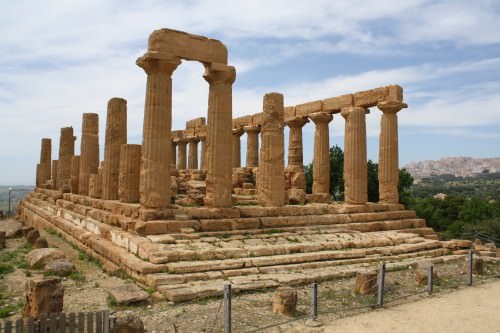 TEMPLE OF JUNO, AGRIGENTO
TEMPLE OF JUNO, AGRIGENTO

| Columns Proportion | 6 : 13 |
|---|---|
| Stylobate | 16.93 x 38.13 m 4 : 9 |
| Intercolumn. Long side (LS) Front side (FS) Middle Intercolumn.(MI) Angle Intercolumn. (AI) | East front 3.05 – 3.08 – 3.15 – 3.08 – 3.04 West front 3.00 – 3.12– 3.13 – 3.13– 3.01 NI LS – 3.07 m AI LS – 3.00 m |
| Corner Contraction | East front – double/complicated. West front – single LS – single |
| Cella Width x Length | 9.51 x 27.8 m |
| Pronaos/Cella Front | 2 in antis; MI – 3.12 m |
| Arrangement of Inner Columns | Staircases |
| Opisthodomos | 2 in antis; MI – 2.98 m |
| Binding of the Cella | Not symmetric |
| Column Height | 6.44 m |
| Lower Diameter | 1.37 m = 4/9 NI |
| Proportions in Elevation | OrderH : StylobateW = 1 : 2 EntablatureH : NormalI = 7 : 10 NormalI : OrderH = 4 : 11 LD : NormalI = 4 : 9 NI = 10 entablature unit |
| Lower D x Column Height | 1 : 5 ¼ |
| Frieze Proportions W=Width; H=Height | TrW : MetW – 2 : 3 TrW : TrH – 3 : 5 ArchW = LD = 4/9 NI |
| Corner Conflict in Frieze | Different solution |
| I' | 32.885 cm |
TEMPLE OF CONCORDIA (AGRIGENTO, C. 425)
 TEMPLE OF CONCORDIA, AGRIGENTO
TEMPLE OF CONCORDIA, AGRIGENTO

| Columns Proportion | 6 x 13 |
|---|---|
| Stylobate | 16.91 x 39.44 m 3 : 7 |
| Intercolumn. Long side (LS) Front side (FS) Middle Intercolumn.(MI) Angle Intercolumn. (AI) | East front 3.00 – 3.10 – 3.20 – 3.09 – 3.01 West front 3.01 – 3.11 – 3.20 – 3.09 – 2.98 NI LS – 3.20 m AI LS – 3.00 m |
| Corner Contraction | Single unit contraction on each side |
| Cella Width x Length | 9.47 x 28.71 x |
| Pronaos/Cella Front | 2 in antis; MI – 2.93 m |
| Arrangement of Inner Columns | staircases |
| Opisthodomos | 2 in antis; MI – 2.95 m |
| Binding of the Cella | classical |
| Column Height | 6.71 m |
| Lower Diameter | 1.42 m |
| Proportions in Elevation | ColumnH : EntablatureH = 1 : 3 EntablatureH : NormalI = 7 : 10 LD : NormalI = 4 : 9 NI = 10 entablature unit |
| Lower D x Column Height | - |
| Frieze Proportions W=Width; H=Height | TrW : MetW – 2 : 3 TrW : TrH – 4 : 7 ArchW : TrW = 1 : 2 |
| Corner Conflict in Frieze | - |
| I' | 32,885 cm Ground plan unit = 15´´= 30,83 cm |
TEMPLE OF DIOSKURI (AGRIGENTO, AFTER 425 BCE)
 TEMPLE OF THE DIOSKOUROI, AGRIGENTO
TEMPLE OF THE DIOSKOUROI, AGRIGENTO

| Columns Proportion | 6 x 13 |
|---|---|
| Stylobate | 13.83 x 31.70 m |
| Intercolumn. Long side (LS) Front side (FS) Middle Intercolumn.(MI) Angle Intercolumn. (AI) | NI = 2.54 m = 125 ´´ AI = 2.43 m = 119 ´´ |
| Corner Contraction | Single (?) |
| Cella Width x Length | - |
| Pronaos/Cella Front | - |
| Arrangement of Inner Columns | - |
| Opisthodomos | - |
| Binding of the Cella | classical (?) |
| Column Height | 5.83 m |
| Lower Diameter | 1.22 m |
| Proportions in Elevation | ColumnH : EntablatureH = 1 : 3,14 EntablatureH : NormalI = 8 : 11 (almost 8 : 12 = 2 : 3) LD : NormalI = 1 : 2,09 NormalI : ColumnH = 1 : 2,29 OrderH : StylobateW = ?5 : 9 |
| Lower D x Column Height | c. 1 : 4 ¾ OD : UD = 4 : 5 |
| Frieze Proportions W=Width; H=Height | TrW : MetW – 2 : 3 ArchW : angle TrW = 1 : 2 |
| Corner Conflict in Frieze | 19, 5 cm (30, 6 cm needed) |
| I' | 32,789 cm Ground plan unit = 25´´ = 51,23 cm |
HEPHAISTOS (AGRIGENTO, 430/400 BCE)
| Columns Proportion | 6 x 13 |
|---|---|
| Stylobate | 13.39 x 31.00 m |
| Intercolumn. Long side (LS) Front side (FS) Middle Intercolumn.(MI) Angle Intercolumn. (AI) | Nl = ca. 3.16 m AI = ca. 3.02 m |
| Corner Contraction | single on the LS needed – 36,1 cm |
| Cella Width x Length | ? 1 : 3 |
| Pronaos/Cella Front | - |
| Arrangement of Inner Columns | - |
| Opisthodomos | 2 in antis (?) |
| Binding of the Cella | classical (?) |
| Column Height | - |
| Lower Diameter | c. 1.51 m |
| Proportions in Elevation | - |
| Lower D x Column Height | - |
| Frieze Proportions W=Width; H=Height | - |
| Corner Conflict in Frieze | - |
| I' | - |
BIG TEMPLE ( SEGESTA, 417/409 BCE)
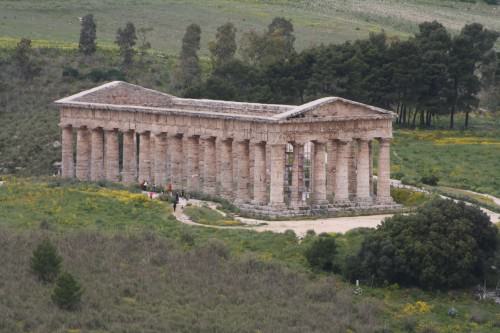 TEMPLE OF SEGESTA
TEMPLE OF SEGESTA

| Columns Proportion | 6 x 14 (3 : 7) |
|---|---|
| Stylobate | Styl: 23.17 x 58.07 m EuthyntW : L = 3 : 7 AxialW : L = 64´x 170´ |
| Intercolumn. Long side (LS) Front side (FS) Middle Intercolumn.(MI) Angle Intercolumn. (AI) | NI LS = 4.35 (13¼´) AI = 12 ½ ´ MI= 13¼ ´ = NI |
| Corner Contraction | double unit contraction on each side |
| Cella Width x Length | - |
| Pronaos/Cella Front | 2 in antis |
| Arrangement of Inner Columns | - |
| Opisthodomos | 2 in antis |
| Binding of the Cella | classical |
| Column Height | 9.33 m |
| Lower Diameter | 1.95 m |
| Proportions in Elevation | Axial W : ColumnH = 4 : 9 EntablatureH : NormalI = 2 : 3 LD : NormalI = 4 : 9 |
| Lower D x Column Height | 1 : 4 ¾ |
| Frieze Proportions W=Width; H=Height | TrW : MetW – 2 : 3 TrW : TrH – 3 : 5 |
| Corner Conflict in Frieze | - |
| I' | 32.861 cm |
GLOSSARY
Adyton - The adyton (Greek: Άδυτον) or adytum (Latin) was a restricted area within the cella of a Greek or Roman temple. The adyton was frequently a small area at the farthest end of the cella from the entrance.
Cella - The cella (from Latin for "small chamber") or naos (from the Greek ναός, "temple"), is the inner chamber of a temple in classical architecture.
Euthynteria - Euthynteria is the ancient Greek term for the uppermost course of a building's foundations, partly emerging from the ground line. The superstructure of the building (stylobate, columns, walls, and entablature) was set on the euthynteria.
Intercolumniation - In architecture intercolumniation is the spacing between columns in a colonnade, as measured at the bottom of their shafts. Unit intercolumniation (NI) is the hypothetical/ initial equal size of the spacing on each side of a temple before the alteration of the spacing. The normal intercolumniation (NI), however, is one that has not been altered in order to achieve a contraction. Middle intercolumniation (MI) is the one between the central two columns at the entrance of a temple, usually on the east front.
Metropolis - In the past, metropolis was the designation for a city or state of origin of a colony.
Opisthodomos - An opisthodomos (ὀπισθόδομος, 'back room') can refer to either the rear room of an ancient Greek temple or to the inner shrine.
Peristasis - The Peristasis (Greek: Περίστασις) was a four-sided porch or hall of columns surrounding the cella in an ancient Greek peripteros temple.
Stylobate - This is the stepped platform on which colonnades of temple columns are placed (it is the floor of the temple). The platform was built on a levelling course that flattened out the ground immediately beneath the temple.
Triglyph and metope - Triglyph is an architectural term for the vertically channelled tablets of the Doric frieze. The rectangular recessed spaces between the triglyphs on a Doric frieze are called metopes.
LICENSE:
Article based on information obtained from these sources:with permission from the Website Ancient History Encyclopedia
Content is available under License Creative Commons: Attribution-NonCommercial-ShareAlike 3.0 Unported. CC-BY-NC-SA License